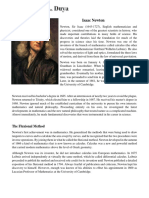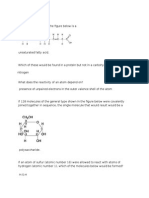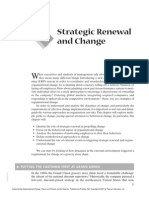Isaac Newton
Isaac Newton
Uploaded by
hanumantdalmiaCopyright:
Available Formats
Isaac Newton
Isaac Newton
Uploaded by
hanumantdalmiaCopyright
Available Formats
Share this document
Did you find this document useful?
Is this content inappropriate?
Copyright:
Available Formats
Isaac Newton
Isaac Newton
Uploaded by
hanumantdalmiaCopyright:
Available Formats
Isaac Newton: A Detailed Study
Early Life
• Birth: Isaac Newton was born on January 4, 1643, in Woolsthorpe, Lincolnshire,
England.
• Family Background: His father, a farmer, died three months before his birth.
Newton's mother remarried when he was three, leaving him to be raised by his
maternal grandmother.
• Education: Newton attended the King's School in Grantham and later enrolled at
Trinity College, Cambridge, in 1661. He graduated in 1665.
Academic Development
• Influence of the Plague: The Great Plague (1665-1666) forced Cambridge to close.
During this time, Newton returned to Woolsthorpe, where he developed many of his
ideas.
• Mathematical Innovations: He worked on calculus, optics, and laws of motion,
laying the groundwork for classical mechanics.
Major Contributions
1. Calculus:
o Independently developed calculus around the same time as Gottfried Wilhelm
Leibniz. Newton's version was based on the concept of "fluxions."
o His work is documented in the "Method of Fluxions" (published
posthumously).
2. Laws of Motion:
o First Law: An object at rest stays at rest, and an object in motion stays in
motion unless acted upon by a force (inertia).
o Second Law: Force equals mass times acceleration (F=maF = maF=ma).
o Third Law: For every action, there is an equal and opposite reaction.
3. Law of Universal Gravitation:
o Proposed that every mass attracts every other mass in the universe. His famous
formulation, F=G⋅m1⋅m2r2F = \frac{G \cdot m_1 \cdot m_2}{r^2}F=r2G⋅m1
⋅m2, describes the gravitational force between two objects.
4. Optics:
o Conducted experiments with prisms, demonstrating that white light is
composed of a spectrum of colors.
o Developed the theory of color and published his findings in "Opticks" (1704).
5. The Principia Mathematica:
o Published in 1687, "Philosophiæ Naturalis Principia Mathematica" (often
referred to as the Principia) is one of the most important works in the history
of science.
o It laid the foundations for classical mechanics and explained his laws of
motion and universal gravitation.
Later Life and Legacy
• Royal Society: Newton was elected a member of the Royal Society in 1672 and
served as its president from 1703 until his death.
• Knighthood: He was knighted by Queen Anne in 1705.
• Death: Newton died on March 31, 1727, and was buried in Westminster Abbey.
Impact on Science
• Scientific Revolution: Newton’s work is considered a cornerstone of the Scientific
Revolution, influencing countless fields such as physics, mathematics, and astronomy.
• Legacy: His methodologies and principles set the stage for future scientists, including
Einstein and the development of modern physics.
Conclusion
Isaac Newton’s contributions to science and mathematics are monumental. His rigorous
approach to experimentation and theory fundamentally changed the way we understand the
natural world. Through his laws of motion and gravitation, he laid the groundwork for
classical mechanics, which remained unchallenged until the advent of modern physics in the
20th century. His legacy continues to inspire and shape scientific thought today.
You might also like
- Sri Sadasiva Brahmendra - Yoga Sudhakara (English)Document254 pagesSri Sadasiva Brahmendra - Yoga Sudhakara (English)booksocialist86% (28)
- Isaac NewtonDocument10 pagesIsaac NewtonJustine Lisette PedrajasNo ratings yet
- Issac Newton Rough Draft v1Document3 pagesIssac Newton Rough Draft v1api-253599101No ratings yet
- Complete Grammar NoteDocument64 pagesComplete Grammar NoteZahidah Husna ZulkifliNo ratings yet
- Information About Isaac Newton - A4Document4 pagesInformation About Isaac Newton - A4johnreybayoguingNo ratings yet
- Isaac Newton: The Fluxional MethodDocument3 pagesIsaac Newton: The Fluxional MethodJajaNo ratings yet
- Who Was Newton?: Theories Calculus, Gravity The Laws of Motion DiedDocument4 pagesWho Was Newton?: Theories Calculus, Gravity The Laws of Motion DiednadhirahNo ratings yet
- Isaack NewtonDocument10 pagesIsaack NewtonPrashant ShindeNo ratings yet
- Contributions of Isaac Newton (Autosaved)Document7 pagesContributions of Isaac Newton (Autosaved)Umer FarooqNo ratings yet
- Isaac Newton - Quotes Collection: Biography, Achievements And Life LessonsFrom EverandIsaac Newton - Quotes Collection: Biography, Achievements And Life LessonsNo ratings yet
- Reading PractiseDocument5 pagesReading Practisepikachucute2107No ratings yet
- Isaac NewtonDocument14 pagesIsaac Newton11Toán1-06-Phạm Lê Bá DươngNo ratings yet
- Gladays R. TanesDocument17 pagesGladays R. TanesTanes Peña Rebosura GladaysNo ratings yet
- Sir Isaac NewtonDocument10 pagesSir Isaac Newtonapi-105955784No ratings yet
- Isaac NewtonDocument21 pagesIsaac Newtonbhaskara the mathematicianNo ratings yet
- WEEK 4 - History of Isaac NewtonDocument2 pagesWEEK 4 - History of Isaac NewtonElok SorayaNo ratings yet
- Isaac NewtonDocument3 pagesIsaac NewtonCourtney LeipertzNo ratings yet
- Lecture 27 Newton Saint of ScienceDocument12 pagesLecture 27 Newton Saint of SciencePathumavathy RamanathanNo ratings yet
- Jennalyn MhayDocument12 pagesJennalyn Mhayjeya julianNo ratings yet
- Principles of Natural Philosophy) Commonly Known As The Principia, AlthoughDocument6 pagesPrinciples of Natural Philosophy) Commonly Known As The Principia, AlthoughazehjNo ratings yet
- Sir Isaac Newton LifeDocument8 pagesSir Isaac Newton LifeNoor Suhaida CNo ratings yet
- Isaac NewtonDocument8 pagesIsaac NewtonManpreet SachdevaNo ratings yet
- Isaac NewtonDocument5 pagesIsaac Newtonapi-270467511No ratings yet
- Road To Ielts (Reading)Document29 pagesRoad To Ielts (Reading)lilyNo ratings yet
- Reading Ac Practice9 GGBFDocument13 pagesReading Ac Practice9 GGBFQuỳnh ViNo ratings yet
- Principia: "The Mathematical Principles of Natural Philosophy"From EverandPrincipia: "The Mathematical Principles of Natural Philosophy"No ratings yet
- Sir Isaac NewtonDocument22 pagesSir Isaac NewtonUpendra Reddy100% (1)
- Tugas Teks Recount Berupa Biografi Tokoh TerkenalDocument3 pagesTugas Teks Recount Berupa Biografi Tokoh Terkenalilhamzulkarnain604No ratings yet
- Assignment No: 1: Govt. Graduate College Chowk AzamDocument5 pagesAssignment No: 1: Govt. Graduate College Chowk AzamMudassarNo ratings yet
- Sir Isaac Newton, PRS, (4 January 1643 - 31 March 1727)Document6 pagesSir Isaac Newton, PRS, (4 January 1643 - 31 March 1727)bookpalNo ratings yet
- Biography of Isaac NewtonDocument7 pagesBiography of Isaac NewtonReyna Avila Ramírez-Arellano100% (1)
- Philosophiæ Naturalis Principia Mathematica: Isaac NewtonDocument6 pagesPhilosophiæ Naturalis Principia Mathematica: Isaac NewtonPedro Soto CruzNo ratings yet
- Isaac Newton - Docx DoneDocument7 pagesIsaac Newton - Docx DoneOmarDeebNo ratings yet
- Sir Isaac Newton: Philosophiæ Naturalis Principia MathematicaDocument9 pagesSir Isaac Newton: Philosophiæ Naturalis Principia Mathematicaohm parmarNo ratings yet
- Isaac Newton: BibliografiaDocument8 pagesIsaac Newton: BibliografiaAbraham ValenciaNo ratings yet
- Worlds Top 10 Physicists of All Time PDFDocument15 pagesWorlds Top 10 Physicists of All Time PDFFadewNo ratings yet
- Essay About Isaac NewtonDocument1 pageEssay About Isaac NewtonMarko MedinNo ratings yet
- Advanced Reading 0990 Non-Fiction Final Signature Assignment123Document4 pagesAdvanced Reading 0990 Non-Fiction Final Signature Assignment123api-251231234No ratings yet
- English Project 1Document8 pagesEnglish Project 1kalpana.chauragadeNo ratings yet
- Newton Vs LeibnizDocument16 pagesNewton Vs Leibnizsweetestreds100% (1)
- Isaac NewonDocument5 pagesIsaac Newonnalel05No ratings yet
- Taller Lec 3Document2 pagesTaller Lec 3tallysluciaNo ratings yet
- Reviewer 1Document11 pagesReviewer 1jamesandreirevilla.lebronNo ratings yet
- physics.bgsu.edu_p433_Spacetime7.htmlDocument20 pagesphysics.bgsu.edu_p433_Spacetime7.htmlmorepal2No ratings yet
- NewtonDocument15 pagesNewtonClaudiu MarinNo ratings yet
- Kliping Fisika Sir Isaac Newton: Nama: Rizal Junianto Kelas: Xi TKR 2 No Absen: 29Document5 pagesKliping Fisika Sir Isaac Newton: Nama: Rizal Junianto Kelas: Xi TKR 2 No Absen: 29bob826No ratings yet
- Philosophiæ Naturalis Principia Mathematica: Sir Isaac NewtonDocument9 pagesPhilosophiæ Naturalis Principia Mathematica: Sir Isaac NewtonManish ShethNo ratings yet
- Last Save Script U2Document5 pagesLast Save Script U2Phạm Việt ThắngNo ratings yet
- Isaac NewtonDocument1 pageIsaac NewtonAlex CîmpeanuNo ratings yet
- Physics ProjectDocument9 pagesPhysics Project78bynzhbpvNo ratings yet
- Isaac NewtonDocument15 pagesIsaac Newtonapi-3855358No ratings yet
- Isaac NewtonDocument13 pagesIsaac NewtonRuban BillaNo ratings yet
- Lectura Isaac NewtonDocument2 pagesLectura Isaac NewtonCESAR MAURICIO RODRIGUEZNo ratings yet
- Sir Isaac NewtonDocument2 pagesSir Isaac NewtonMary Grace Herbania-Dahan LundayNo ratings yet
- Isaac Newton: The Smartest Person That Ever Lived - Biography of Famous People Grade 3 | Children's Biography BooksFrom EverandIsaac Newton: The Smartest Person That Ever Lived - Biography of Famous People Grade 3 | Children's Biography BooksNo ratings yet
- Sir Isaac NewtonDocument13 pagesSir Isaac Newtonanu rettiNo ratings yet
- Research 1 PHYSICSDocument2 pagesResearch 1 PHYSICSdivine de GuzmanNo ratings yet
- Saac Newton: Early Life and EducationDocument9 pagesSaac Newton: Early Life and EducationGabriel André AlvesNo ratings yet
- P350 PP1 NewtonDocument6 pagesP350 PP1 Newtonnikesh_prasadNo ratings yet
- English Reading Comprehension - Comprensión de Lectura en Inglés2Document2 pagesEnglish Reading Comprehension - Comprensión de Lectura en Inglés2CESAR MAURICIO RODRIGUEZNo ratings yet
- ABOUT NEWTONDocument2 pagesABOUT NEWTONrouter404.exeNo ratings yet
- Rosati Et Al 2014 Comparative Developmental Psychology How Is Human Cognitive Development UniqueDocument26 pagesRosati Et Al 2014 Comparative Developmental Psychology How Is Human Cognitive Development UniqueTri PuspitaNo ratings yet
- Final ProjcetDocument76 pagesFinal Projcetpower pandiNo ratings yet
- Donna Patrick PDFDocument250 pagesDonna Patrick PDFPetiscos PetiscosNo ratings yet
- Potentiostat 605 ManualDocument43 pagesPotentiostat 605 ManualSaheed AdewaleNo ratings yet
- Scienc City ParkDocument20 pagesScienc City ParkShashank Goyal100% (1)
- Back Propogation AlgorithmDocument17 pagesBack Propogation AlgorithmABCNo ratings yet
- Peta 1 PDFDocument4 pagesPeta 1 PDFJohn Benz SamsonNo ratings yet
- LLDA Clearance Requirement ChecklistDocument1 pageLLDA Clearance Requirement ChecklistJamina CaliganNo ratings yet
- Complete ICT For Igcse Revision GuideDocument178 pagesComplete ICT For Igcse Revision GuideYasmin Yehia100% (1)
- PAMPHLETDocument3 pagesPAMPHLETashleyevakatelynNo ratings yet
- Red CokkiesDocument113 pagesRed CokkiesKhalid GulNo ratings yet
- PALM Flat Scanner: For General Weld InspectionDocument4 pagesPALM Flat Scanner: For General Weld InspectionYoucef ChorfaNo ratings yet
- TranscriptDocument3 pagesTranscriptapi-706430661No ratings yet
- How Individuals Can Drive Climate Action: Australian Centre For Education TrainingDocument12 pagesHow Individuals Can Drive Climate Action: Australian Centre For Education Trainingapi-524326187No ratings yet
- Transport of Critically Ill Patients: MuttaqinDocument14 pagesTransport of Critically Ill Patients: MuttaqintaqinosNo ratings yet
- Honors Biology Midterm Study GuideDocument17 pagesHonors Biology Midterm Study GuideEmilyNo ratings yet
- Ca - Pefy P80 - 250VMH e FDocument1 pageCa - Pefy P80 - 250VMH e FAnnie CortezNo ratings yet
- Greenovator ProfileDocument18 pagesGreenovator Profilemyint myatthuNo ratings yet
- Chapters Page No.: AcknowledgementDocument7 pagesChapters Page No.: AcknowledgementBrian FreemanNo ratings yet
- PreviewpdfDocument39 pagesPreviewpdfmiranda gitawNo ratings yet
- Bob Dean UFO Conf 2009 PDFDocument35 pagesBob Dean UFO Conf 2009 PDFodiv100% (1)
- 2862Document7 pages2862Yuvaraj RajNo ratings yet
- Chapter 3 BiorationalDocument77 pagesChapter 3 BiorationalHanifahEviMNo ratings yet
- MGT320 Ch01Document24 pagesMGT320 Ch01Payman RowhaniNo ratings yet
- Indianoil'S Policy: Sustainability & CSRDocument2 pagesIndianoil'S Policy: Sustainability & CSRSanjayNo ratings yet
- tECHNO GEDocument14 pagestECHNO GESrinjoy SarkarNo ratings yet
- Adam's Learning Centre, Lahore: Simple Final AccountsDocument10 pagesAdam's Learning Centre, Lahore: Simple Final AccountsMasood Ahmad AadamNo ratings yet
- Lecture-4 - Introduction To Contrcts and ObligationsDocument27 pagesLecture-4 - Introduction To Contrcts and ObligationsJoseph Berlin JuanzonNo ratings yet

























































































